As online shopping grows more exciting, customers expect rich, convenient experiences, and they expect them now. Augmented Reality (AR) and Virtual Reality (VR) in e-commerce make that possible. These technologies enable customers to "try before they buy," combining the best of in store shopping with the ease of online shopping.
We’ll look at real life examples, key industry data, and practical tips for AR/VR integration for e-commerce platforms, so you can offer immersive e-commerce experiences that customers crave. We also explore how comprehensive retail & e-commerce solutions support AR/VR adoption in digital commerce.
Introduction: The AR/VR Revolution in E-commerce Shopping
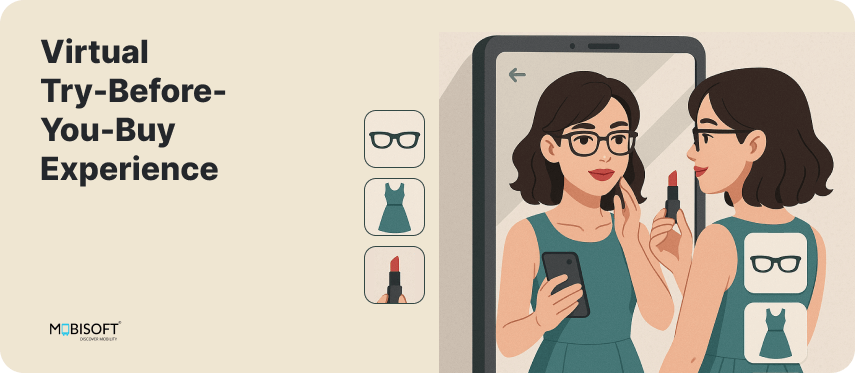
E-commerce has always struggled with a fundamental limitation: customers can’t physically interact with products before buying. AR and VR in e-commerce are changing this paradigm, offering shoppers the ability to “try before they buy,” visualize products in their environment, and enjoy interactive shopping with AR/VR technologies. These innovations are not just novelties; they deliver measurable value from higher sales to lower return rates and stronger brand loyalty.
What Are AR and VR in E-commerce Platforms?
Augmented Reality (AR) in Online Retail
AR in e-commerce superimposes computer generated information like images, 3D models, or videos on the real world, usually through smartphones or tablets. On online retail platforms, augmented reality in online retail allows consumers to see how products look in their environment (e.g., how a piece of furniture would look in the sitting room) or try on items such as makeup, spectacles, or clothing.
Virtual Reality (VR) in E-commerce Platforms
Virtual reality in ecommerce platforms creates fully immersive 3D shopping environments. Customers can browse virtual showrooms for e-commerce, walk down aisles, and interact with products via VR headsets or webbased 3D simulations. These VR shopping experiences mimic in store engagement and bring online shopping to life.
Source: What are AR/VR? And how does it enhance customer experience in e-commerce?
Key Benefits of AR/VR Integration for Online Stores
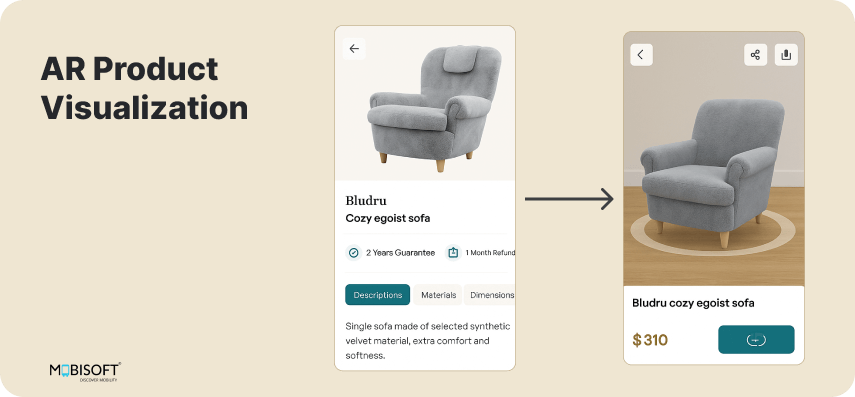
3D Product Previews and Enhanced AR Product Visualization
3D product previews in ecommerce let customers manipulate items from all angles. For example, furniture retailers let shoppers place true-to-scale models in their homes, reducing uncertainty and increasing confidence in purchase decisions.
Virtual Try-Ons for E-commerce Fashion
One of the most popular AR applications is the virtual try-on, enabling customers to see how clothing, accessories, or cosmetics will look on them before purchasing. This feature is widely used in beauty, fashion, and eyewear, reducing ambiguity and boosting customer satisfaction. Fashion retailers are also using product configurators for fashion brands to enhance customization and fit.
Immersive E-commerce Experiences with Virtual Store Showrooms
Virtual reality in e-commerce empowers brands to build branded 3D store environments. Customers can browse, interact with products, and even chat with virtual sales reps. These environments allow for AR/VR marketing strategies for ecommerce, with updated product placements, seasonal designs, and promotional offers. Brands are also leveraging the metaverse and 3D space development for e-commerce to create next generation virtual storefronts.

Increased Engagement and Dwell Time
AR/VR experiences are inherently interactive and engaging, keeping customers on websites longer. Extended dwell time correlates with higher conversion rates and increased likelihood of repeat visits.
How AR/VR Increases Online Sales and Reduces Returns
Accurate visualization and try-on features minimize post-purchase regret. Companies like IKEA and Gunner Kennels saw conversion boosts and return rate reductions after integrating AR features, proving how AR/VR increases online sales and enhances shopping satisfaction.
Personalized Shopping Using AR/VR and AI
AR/VR technologies, especially when combined with AI, enable highly personalized shopping journeys. They can recommend products based on user preferences, behavior, and even their physical environment, leading to more relevant suggestions and increased sales.
Operational Efficiency with AR/VR Plugins
AR/VR can shorten the sales cycle and reduce operational costs. Retailers can showcase products virtually before they’re physically available, optimize inventory by gauging interest in new items, and minimize the need for physical samples or showrooms. Many brands are exploring AR/VR plugins for online stores to scale faster with fewer logistics. Know more about scalable e-commerce solutions for immersive experiences to support such transformations.
Always-On, Global Shopping
Virtual environments are accessible 24/7, breaking down geographic and time-zone barriers. Customers can shop and interact with products anytime, anywhere, expanding the reach of e-commerce brands. Building a virtual showroom for e-commerce helps meet global demand with consistency.
Source: The integration of AR and VR apps in e-commerce- Asioso
Case Studies: Real-World Examples of AR/VR in E-commerce
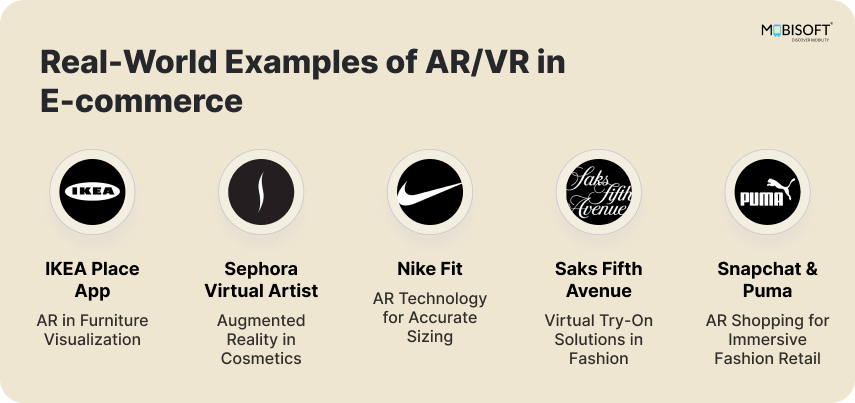
IKEA Place App – AR in Furniture Visualization
Allows users to visualize furniture in their homes using AR, resulting in a 30% reduction in return rates and millions of app downloads.
Sephora Virtual Artist – Augmented Reality in Cosmetics
Enables customers to try on makeup virtually, increasing buyer confidence and purchase intent.
Nike Fit – AR Technology for Accurate Sizing
Uses AR to help customers find the perfect shoe size, reducing sizing errors and returns.
Saks Fifth Avenue – Virtual Try-On Solutions in Fashion
Offers virtual try-ons for clothing and accessories, accessible both-in-store and at home, improving buyer confidence and reducing returns.
Snapchat & Puma – AR Shopping for Immersive Fashion Retail
Launched AR powered “Dress Up” features for immersive fashion shopping, engaging millions of users.
Source: Case Studies of Augmented Reality in the e-Commerce Sector
Challenges of AR/VR Integration for E-commerce Businesses
While the benefits are substantial, integrating AR and VR in ecommerce comes with challenges:
Development Costs
High quality AR/VR experiences require investment in technology and content creation, particularly for shopify headless architecture for AR/VR storefronts or custom development.
Technical Barriers
Not all users have compatible devices or fast internet connections. This can affect the effectiveness of AR/VR integration for ecommerce platforms.
Data Privacy
Collecting and using customer data for personalization must comply with privacy regulations. This becomes even more critical with context-aware AR/VR recommendations.
Content Quality
Success depends on realistic, accurate 3D models and seamless user experiences.
Source: Overcoming challenges in AR adoption
The Future of AR/VR in E-commerce Technology
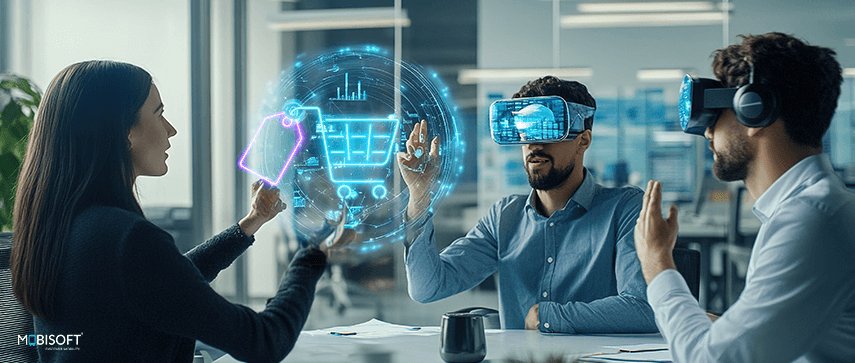
The future points toward even more immersive, personalized, and accessible AR/VR shopping experiences:
Hyper-personalization
AI driven recommendations and environments tailored to each user
AR Cloud
Persistent, shared augmented spaces that blend physical and virtual shopping.
Multi-sensory Experiences
Haptic feedback and advanced sensory tech to simulate touch and feel.
Social Commerce
AR/VR powered shopping on social platforms, blending entertainment and retail.
Source: How AR/VR is shaping the future of commerce
FAQs: Implementing AR and VR in Online Retail
Q: How do AR and VR improve e-commerce sales?
A: By enabling virtual try-ons, accurate product visualization, and immersive experiences, AR/VR boosts customer confidence, increases engagement, and reduces returns, leading to higher conversions and sales.
Q: Are AR/VR features only for large brands?
A: While early adoption was led by big brands, platforms like Shopify now offer AR/VR tools for businesses of all sizes, making these technologies more accessible.
Q: What is the impact on return rates?
A: Brands have reported return rate reductions of 5–30% after implementing AR features, thanks to better product fit and visualization.
Q: Is AR/VR integration expensive?
A: Costs are decreasing as technology matures, and the ROI is increasingly evident through higher sales, reduced returns, and enhanced customer loyalty.
Conclusion: Elevate Online Shopping with AR/VR E-commerce Solutions
Integrating AR and VR in e-commerce is no longer a futuristic luxury; it’s a proven strategy for boosting engagement, increasing conversions, and enhancing customer satisfaction. As augmented and virtual reality in online retail becomes mainstream, brands investing in immersive, interactive shopping experiences will stand out in a competitive digital marketplace. You can also explore our custom e-commerce solutions tailored for AR and VR integration to stay ahead of the curve.
Ready to transform your e-commerce store with AR/VR?
Contact Mobisoft Infotech for innovative, scalable AR/VR e-commerce solutions that deliver real results.
Explore our AR/VR-powered ecommerce platforms and elevate your customers’ shopping experience today!
Citations:
1. How AR and VR are Transforming E-commerce | Synoptek
2. How AR and VR Redefined the Online and In-store Experience
3. How AR and VR are Transforming eCommerce
4. Augmented Reality in eCommerce: Use Cases | Blog Miquido
5. Augmented Reality In Retail: Strategy, Use Cases & Examples
6. The integration of AR and VR apps in e-commerce | asioso
7. AR in eCommerce: Use cases and best examples 2025
8. AR + VR + eCommerce: What Are the Top 3 Trends to Watch Now?
9. Why Augmented Reality is the Future of eCommerce
10. The Impact of AR/VR on Еcommerce: How Technologies Are Changing the Way We Shop Online
11. Augmented Reality in eCommerce: Benefits + Case Studies
12. Augmented reality examples in e-commerce: A new shopping experience
13. The Transformative Role of AR and VR in the E-commerce Industry - Webcreta Technologies
14. eCommerce Technology: Top 10 Trends Shaping 2025's Retail Landscape
15. AR in eCommerce – 10 benefits, use cases, and real-world examples for businesses
16. 12 E-Commerce Trends to Follow in 2025
17. How VR and AR are enhancing customer experience in e-commerce
18. Augmented Reality in E-commerce: How Does it Work?
19. AR and VR in E-Commerce Apps: Enhancing the Online Shopping Experience
20. How AR & VR Are Revolutionizing the eCommerce Experience in 2025 | MinovaEdge
21. AR for E-commerce: Benefits + Case Studies for a Transformed Industry
22. The Role of AR and VR in Shaping E-Commerce: A Literature Review | Global Journal of Enterprise Information Systems
24. From AI To AR: The Bold Innovations Defining E-Commerce In 2025
25. Virtual Shopping: The Pros and Cons of VR and AR | iO


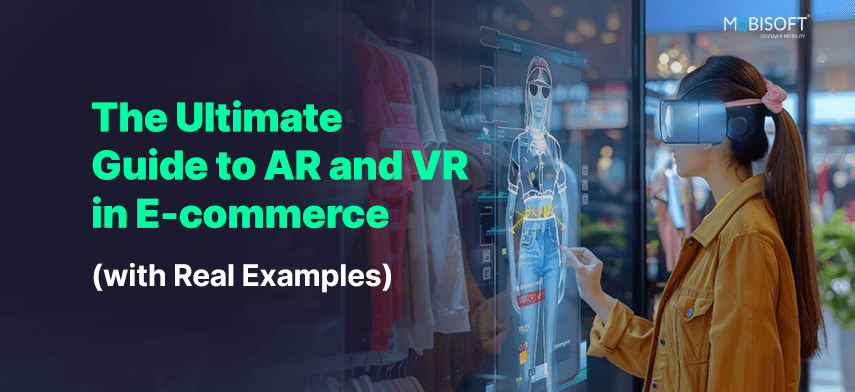


 June 20, 2025
June 20, 2025


